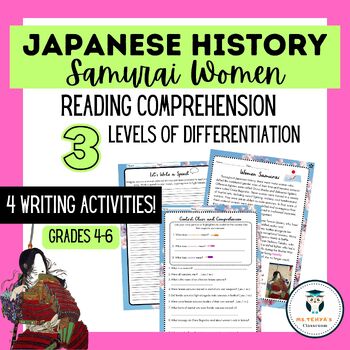Reading Comprehension | Writing Activities | Samurai Women
- PDF
Description
Looking for a fun and engaging way to teach your students about the Onna Bugeisha, the female samurais of ancient Japan? Look no further! This differentiated reading comprehension text and writing activities are just what you need! It's fun and engaging with no prep! Just print and GO!
This resource is designed for upper elementary students, ranging from 4th to 6th-grade levels, and is perfect for teachers who want to provide their students with engaging and informative materials that meet common core standards.
Resource includes
⭐️3 differentiated informative texts
⭐️3 differentiated comprehension and vocabulary worksheets
⭐️4 writing activities
⭐Answer sheets
⭐️black and white printer-friendly versions of all recourses
How to use
⭐️Whole class lesson
⭐️small group
⭐️extra credit
⭐️Socials Studies
⭐️morning work
⭐️etc.
Students will learn about the challenges these women faced and the training they received to become skilled in various forms of martial arts. They will also discover that Onna Bugeisha played a vital role in battles and wars and how their contributions continue to inspire people today.
But this recourse doesn't stop there! It also offers a range of writing activities that allow students to explore and reflect on what they have learned. From writing a diary entry from the perspective of an Onna Bugeisha to creating a comic strip about the lives of these warriors, students will have the opportunity to engage with the material in a fun and creative way. These activities are designed to help students develop their writing skills while deepening their understanding of the Onna Bugeisha and their historical significance.
This resource is a must-have for any teacher looking to add some excitement and diversity to their curriculum!
4th Grade Text:
- CCSS.ELA-LITERACY.RI.4.1: Refer to details and examples in a text when explaining what the text says explicitly and when drawing inferences from the text.
- CCSS.ELA-LITERACY.RI.4.3: Explain events, procedures, ideas, or concepts in a historical, scientific, or technical text, including what happened and why, based on specific information in the text.
- CCSS.ELA-LITERACY.RI.4.8: Explain how an author uses reasons and evidence to support particular points in a text.
5th Grade Text:
- CCSS.ELA-LITERACY.RI.5.1: Quote accurately from a text when explaining what the text says explicitly and when drawing inferences from the text.
- CCSS.ELA-LITERACY.RI.5.3: Explain the relationships or interactions between two or more individuals, events, ideas, or concepts in a historical, scientific, or technical text based on specific information in the text.
- CCSS.ELA-LITERACY.RI.5.8: Explain how an author uses reasons and evidence to support particular points in a text.
6th Grade Text:
- CCSS.ELA-LITERACY.RI.6.1: Cite textual evidence to support analysis of what the text says explicitly as well as inferences drawn from the text.
- CCSS.ELA-LITERACY.RI.6.2: Determine a central idea of a text and how it is conveyed through particular details; provide a summary of the text distinct from personal opinions or judgments.
- CCSS.ELA-LITERACY.RI.6.8: Trace and evaluate the argument and specific claims in a text, distinguishing claims that are supported by reasons and evidence from claims that are not.





